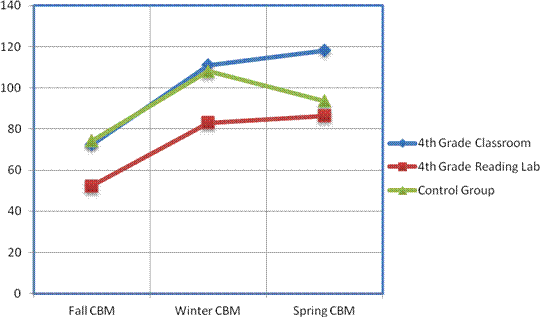Word Warm-ups Studies
Case studies conducted in a regular fourth grade classroom and in a fourth grade reading lab over the 2007-2008 school year show that students using Word Warm-ups combined with Read Naturally’s fluency program or vocabulary program showed observable gains in word recognition and fluency.
Study 1: Word Warm-ups and Read Naturally
A case study conducted in a regular fourth grade classroom and in a fourth grade reading intervention lab over the 2007-2008 school year shows that students using Word Warm-ups combined with Read Naturally’s fluency program made observable gains in word recognition and fluency.
During the 2007-2008 school year, fourth grade students in a Minneapolis, MN school participated in a study using a combination of two Read Naturally programs: Word Warm-ups and Read Naturally SE (Software Edition) or ME (Masters Edition). Fall Curriculum-Based Measures (CBM) scores were used as a screening assessment to identify thirteen students who had low fluency scores. These students were further assessed using the Word Warm-ups Student Assessment (to diagnose phonics strengths and weaknesses), the San Diego Quick Assessment (to determine approximate reading level using graded word lists), and the Read Naturally placement passages (to determine placement level and establish a fluency goal).
From the 13 students, five were selected for the treatment group in a fourth grade reading intervention lab setting, and five were selected for small group instruction in a regular fourth grade classroom. These study group students worked in Word Warm-ups 2 and Word Warm-ups 3 and Read Naturally SE or ME. Students worked in these interventions three to five days per week for 30 to 45 minutes daily from September 2007 through May 2008. In Study Group 1, students moved back and forth between the two programs as they met passing requirements for each exercise or story. In Study Group 2, students did Word Warm-ups for the first ten minutes of each period and then transitioned to Read Naturally fluency. The remaining three students received regular core instruction.
All 13 students were reassessed in fluency using the winter CBM in January, and again using the spring CBM in June. The San Diego Quick Assessment and the Word Warm-ups Student Assessment were given again as post-tests in June as well. Students in the study groups made greater observable gains in word recognition, phonics skills, and fluency.
| Group | No. of Students | Grade | Average Graded Word List Growth (Word Recognition) | Average Increase of Correct Items on Word Warm-ups Student Assessment (Phonics Skills) | Average Fluency Growth, Fall to Spring | Average Weekly wcpm Increase, Fall to Spring |
|---|---|---|---|---|---|---|
| Study Group 1 (Fourth Grade Regular Classroom) | 5 | 4 | 1.4 grade levels | 9.8 (26%) | 46 wcpm | 1.43 words |
| Study Group 2 (Fourth Grade Reading Lab) | 5 | 4 | 1.8 grade levels | 11 (29%) | 34 wcpm | 1.06 words |
| Control | 3 | 4 | 0.7 grade level | 3 (8%) | 19 wcpm | .6 words |

Based on the Hasbrouck & Tindal Oral Reading Fluency Data, fourth grade students at the 50th percentile in fluency in the fall made an average weekly improvement of less than one word per week. In this case study, Study Group 1 made an average weekly gain of 1.43 wcpm, and Study Group 2 made an average weekly gain of 1.06 wcpm. The control group made an average weekly gain of only .6 wcpm.
Additional Studies and Reviews
Overview of Additional Studies and Reviews
Additional Read Naturally Strategy Studies
- Nickodem, K. and Dupuis, D. (2017): New findings on Read Naturally Live
- Heistad, D. (2004): The effects of Read Naturally on fluency and reading comprehension (two-school study)
- Johnson, G. and Weaver, J.: Special education students, grades 3 through 8, Huron County, MI
- Ihnot, C. and Marston, D. (1990): Using teacher modeling and repeated reading to improve the reading performance of mildly handicapped students
Reviews of Read Naturally
- University Study of Read Naturally Gets High Rating From NCII
- FCRR and U of Oregon Give Read Naturally Highest Ratings
- Chart Comparing WWC, FCRR, University of Oregon, and NCRTI
- Hancock Study Author States Study Was Not Intended to Evaluate Read Naturally
- Review of Kemp Study Deceives Educators
Word Warm-ups Studies
Take Aim at Vocabulary Studies
Please let us know what questions you have so we can assist. For Technical Support, please call us or submit a software support request.